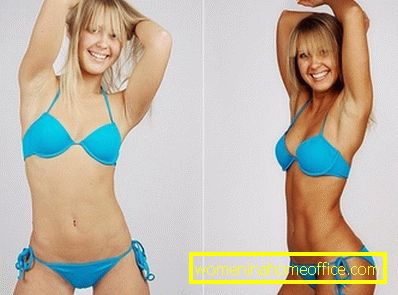Sunbathe taking into account the skin phototype
Tanning, obtained under the influence of sunlight or tanning lamp, is very important for our skin and the body as a whole. You can even say - invaluable. It improves the person’s resistance to disease and protects against solar radiation. A positive effect on metabolism, blood pressure and cholesterol levels. Reduces the pain threshold in those people who suffer from rheumatism and muscle pain. It is successfully used as a prophylactic agent of osteoporosis.

The fact that the mood improves and the vitality of the body rises, and there is nothing to say. Fighting stressful situations and overwork, taking into account modern living conditions (meaning a very active life rhythm and the presence of multiple stimuli) is an important matter.
In addition, sunlight provides a more active production of vitamin D, which is very important for the human body. It is important for our skeleton.
All of the above benefits of tanning will only be realized when we provide the right conditions for tanning. You can read about them on our website in the articles "Instant Tanning and How to Achieve It" and "We Tan Wisely in a Tanning Salon."
Yes, of course, we all know that to lie in the sun is to burn. Excessive exposure to ultraviolet rays on our skin - it is also the way to cancer. It is important to remember this moment when you are planning to visit the beach or to visit the solarium.
“To know everything in measure” is a golden rule that suits absolutely all life situations. However, how to accurately determine this measure in relation to tanning? Where is the tight time frame, limiting the permissibility of being in the sun or in a solarium?
If you speak not scientifically and very generalized, it is desirable to tan so:
- before noon and after four in the evening;
- use tanning products;
- for fifteen minutes it is necessary to warm the back and chest;
- in the case of a tanning bed, the periods of “lying,” “sitting,” or “standing,” are determined on the basis of its type and power.
Good specialists in the field of cosmetology say that the period of exposure to ultraviolet radiation on the skin must necessarily be repelled by the type of skin. He is also called phototype. To approach the definition of tanning time through a phototype is a correct and scientifically sound method.
The fact is that different types of human skin cover react differently to exposure to light sources. That is why we all get different tanning (by skin tone) and why someone needs more sunbathing for a deep bronze ebb, and someone less.
Different skin phototypes are completely differently prone to sunburn and differ in the special nature of their reaction. The phototype is an innate, not an acquired feature of each person. It does not change throughout the life path.
And so, we decided that to establish a time frame for tanning, it is important to determine your skin phototype. This will not be difficult for the external features of your body. As they say, you can install it "by eye".
If you are doubted that you are right, you can contact the specialists. When visiting beauty salons in order to use their tanning beds to get the effect of bronze skin, the staff of these salons are simply obliged to test you for a photo type. If they don’t do this, then I have only one piece of advice for you - run out of this cabin to hell, namely the other.
The breakdown into photo types, which is interesting, is not straightforward. There are various theories about this. However, a classic breakdown is highlighted. It is based on it modern medicine. In accordance with generally accepted standards, there are six skin phototypes.
Six skin phototypes

First phototype
Skin: very light, white.
Eyes: blue or green.
Hair: blond or very blond.
The result of tanning: the skin always burns and does not tan.
Second phototype
Skin: light.
Eyes: green or brown.
Hair: colors of sand or light brown.
Tanning result: skin sometimes tans; can quickly get burnt.
Third photo type
Skin: Olive or ivory.
Eyes: brown.
Hair: light brown, dark brown, less often black.
The result of tanning: the skin often sunbathes, sometimes it burns.
Fourth photo type
Skin: olive green.
Eyes: dark brown or black.
Hair: dark brown or black.
Result of tanning: tanning is very good.
Fifth phototype
Skin: dark brown.
Eyes: black.
Black hair.
Tanning result: a very rich and fast tan. The skin does not burn under the influence of ultraviolet radiation.
Sixth photo type
Leather: black.
Eyes: black.
Black hair.
Tanning result: a very deep and lasting tan. The skin is deeply pigmented.
They are all subject to both good and bad tanning effects. So, for example, skin cancer can be a problem for any of them. The difference is only in the degree of risk to earn it. Scientists believe that the representatives of the first and second skin phototype are most susceptible to cancer associated with exposure to ultraviolet radiation. These are the so-called risk groups.
People who are on the external signs of the third and fourth phototypes, are less prone to the appearance of skin cancer. The fifth and sixth phototypes are the least exposed to the dangerous effects of ultraviolet radiation. People belonging to them may suffer from melanoma of the palms and feet, as well as their weak places are considered the surface of the mucous membranes.
All over the world it is believed that dark skin is formed in harsh conditions for it. Accordingly, it has a higher level of protection and resistance to various environmental factors.
The phototype is taken into account not only when choosing the time of exposure to the skin of the ultraviolet, but also for the correct acquisition of sunscreen. Among other things, those who wish to try on themselves serious cosmetic procedures, for example, deep chemical peeling, are also simply obliged to take into account their phototype of the skin. Besides him, of course, it is important to pay attention to the condition and age of the skin.
The division into phototypes of the skin was initially used when a person was exposed to laser and other devices whose effect is connected with the irradiation of the skin.
Today there is a whole school - Lancer's Ethnic Scale (LES). Its creator is the doctor of medicine Harold F. Lancer. He focuses not only on the phototype, but also on the ethnicity of your distant relatives. Also very, very interesting position.
Safe and correct phototherapy in medicine is based on three elements:
- The first element. Doctors determine your skin phototype.
- The second element. Depending on the results of the first set radiation intensity.
- The third element. The dose of ultraviolet radiation selected for the patient is compared with the phototoxic dose.
Improper selection of a dose of ultraviolet radiation will lead to drying of the skin, accelerating the aging process of the skin and a number of very unpleasant diseases. That is why it is so important to decide on your skin photo type, to approach the issue seriously and thoroughly.
Let the tan be only in joy and will benefit you. The beauty of your skin depends on how you yourself approach the task of caring for it and how carefully you will take care of it.